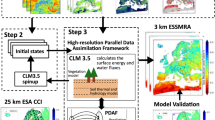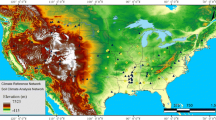Abstract
Low-frequency microwave satellite observations are sensitive to land surface soil moisture (SM). Using satellite microwave brightness temperature observations to improve SM simulations of numerical weather, climate and hydrological predictions is one of the most active research areas of the geoscience community. In this paper, Yan and Jins’ (J Radio Sci 19(4):386–392, 2004) theory on the relationship between satellite microwave remote sensing polarization index and SM is used to estimate land surface SM values from the advanced microwave scanning radiometer-E (AMSR-E) brightness temperature data. With consideration of soil texture, surface roughness, optical thickness, and the monthly means of NASA AMSR-E SM data products, the regional daily land surface SM values are estimated over the eastern part of the Qinghai-Tibet Plateau. The resulting SM retrievals are better than the NASA daily AMSR-E SM product. The retrieved SM values are generally lower than the ground measurements from the Maqu Station (33.85°N, 102.57°E) and the Tanglha Station (33.07°N, 91.94°E) and the US NCEP reanalysis data, but the temporal variations of the retrieved SM demonstrate more realistic response to the observed precipitation events. In order to improve the land surface SM simulating ability of the weather research and forecasting model, the retrieved SM was assimilated into the Noah land surface model by the Newtonian relaxation (NR) method. A direct insertion method was also applied for comparison. The results indicate that fine-tuning the quality factor in the NR method improves the simulated SM values most for desert areas, followed by grasslands, and shrub and grass mixed zones at the regional scale. At the temporal scale, the NR method decreased the root mean square error between the simulated SM and actual observed SM by 0.03 and 0.07 m3/m3 at the Maqu and Tanglha Stations, respectively, and the temporal variation of simulated SM values was much closer to the ground-measured SM values.





Similar content being viewed by others

References
Caya A, Sun J, Snyder C (2005) A comparison between the 4DVAR and the ensemble Kalman filter techniques for radar data assimilation. Mon Weather Rev 133:3081–3094
Chen F, Dudhia J (2001) Coupling an advanced land-surface/hydrology model with the Penn State/NCAR MM5 modeling system, Part I: model description and implementation. Mon Weather Rev 129(4):569–585
Clark CA, Arritt RW (1995) Numerical simulations of the effect of soil moisture and vegetation cover on the development of deep convection. J Appl Meteorol 34:2029–2045
Cosby BJ, Hornberger GM, Clapp RB, Ginn TR (1984) A statistical exploration of the relationships of soil moisture characteristics to the physical properties of soils. Water Resour Res 20(6):682–690
Crow WT, Wood EF (2003) The assimilation of remotely sensed soil brightness temperature imagery into a land surface model using ensemble Kalman filtering: a case study based on ESTAR measurements during SGP97. Adv Water Resour 26:137–149
Gallus WA Jr, Segal M (2000) Sensitivity of forecast rainfall in a Texas convective system to soil moisture and convective parameterization. Weather Forecast 15:509–525
Gao H, Wood EF, Jackson TJ, Drusch M (2006) Using TRMM/TMI to retrieve surface soil moisture over the southern United States from 1998 to 2002. J Hydrometeorol 7(1):23–38
Gruhier C, Rosnay PD, Kerr Y, Mougin E, Ceschia E, Calvet J-C, Richaume P (2008) Evaluation of AMSR-E soil moisture product based on ground measurements over temperate and semi-arid regions. Geophys Res Lett 35:L10405. doi:10410.11029/12008GL033330
Hallikainen MT, Ulaby FT, Dobson MC, El-Rayes MA (1985) Microwave dielectric behavior of wet soil-part 1: empirical models and experimental observations. IEEE Trans Geosci Remote Sens GE-23(1):25–34
Hoke J, Anthes R (1976) The initialization of numerical models by a dynamic relaxation technique. Mon Weather Rev 104:1551–1556
Hurkmans R, Paniconi C, Troch PA (2006) Numerical assessment of a dynamical relaxation data assimilation scheme for a catchment hydrological model. Hydrol Process 20(3):549–563
Jackson TJ (1993) Measuring surface soil moisture using passive microwave remote sensing. Hydrol Process 7(2):139–152
Jackson TJ, Hsu AY, O’Neill PE (2002) Surface soil moisture retrieval and mapping using high-frequency microwave satellite observation in the southern great plain. J Hydrometeorol 3:688–699
Jin Y-Q (1998) Monitoring regional sea ice of China’s Bohai Sea by SSM/I scattering indexes. IEEE J Ocean Eng 23(2):141–144
Koike T, Fujii H, Tamagawa K (2000) Development and validation of microwave radiometer algorithms for land surface hydrology. Int Symp Remote Sens, Kyongju, Korea, pp 503–508
Meesters AGCA, Jeu RAMD, Owe M (2005) Analytical derivation of the vegetation optical depth from the microwave polarization difference index. IEEE Geosci Remote Sens Lett 2(2):121–123
Njoku EG, Chan SK (2006) Vegetation and surface roughness effects on AMSR-E land observations. Remote Sens Environ 100(2):190–199
Njoku EG, Li L (1999) Retrieval of land surface parameters using passive microwave measurements at 6–18 GHz. IEEE Trans Geosci Remote Sens 37(1):79–92
Njoku EG, Jackson TJ, Lakshmi V, Chan TK, Nghiem SV (2003) Soil moisture retrieval from AMSR-E. IEEE Trans Geosci Remote Sens 41(2):215–229
Ookouchi Y, Segal M, Kessler RC, Piekle RA (1984) Evaluation of soil moisture effects on generation and modification of mesoscale circulations. Mon Weather Rev 112:2281–2292
Paniconi C, Marrocu M, Putti M, Verbunt M (2003) Newtonian nudging for a Richards equation-based distributed hydrological model. Adv Water Resour 26:161–178
Prigent C, Aires F, Rossow WB, Robock A (2005) Sensitivity of satellite microwave and infrared observation to soil moisture at a global scale: relationship of satellite observations to in situ soil moisture measurements. J Geophys Res 110:D07110. doi:07110.01029/02004JD005087
Ulaby FT, Moore RK, Fung AK (1981) Microwave remote sensing: active and passive. Vol. 1: microwave remote sensing fundamentals and radiometry. Addison-Wesley, Reading, MA, pp 456
Vinnikov KY, Yeserkepova IB (1991) Soil moisture: empirical data and model results. J Clim 4(1):66–79
Vinnikov KY, Robock A, Qiu S, Entin JK (1999) Satellite remote sensing of soil moisture in Illinois, United States. J Geophys Res 104(D4):4145–4168
Wagner W, Scipal K, Pathe C, Gerten D, Lucht W, Rudolf B (2003) Evaluation of the agreement between the first global remotely sensed soil moisture data with model and precipitation data. J Geophys Res 108(D19):4611. doi:4610.1029/2003JD003663
Wang L, Li Z, Chen Q (2006) New calibration method for soil roughness parameters with AMSR-E observations. J Remote Sens 10(10):654–660 (in Chinese)
Wei M-Y (1995) Soil moisture: report of a workshop held in Tiburon, California, 25–27 January 1994, NASA Conf Publ 3319, pp 80
Wen J, Jackson TJ, Bindlish R (2005) Retrieval of soil moisture and vegetation water content using SSM/I data over a corn and soybean region. J Hydrometeorol 6(6):854–863
Wu G-X, Liu Y-M, Liu X, Duan A-M, Liang X-Y (2005) How the heating over the Tibetan plateau affects the Asian climate in summer. J Atmos Sci 29(1):47–56 (in Chinese)
Yan FH, Jin YQ (2004) Statistics of the average distance of polarization index derived from data of space-borne microwave remote sensing and soil moisture mapping. J Radio Sci 19(4):386–392 (in Chinese)
Zhao YZ, Ma YM, Huang Z, Yuan T (2007) The retrieval of soil moisture from TRMM/TMI data in central of Tibetan plateau. Plateau Meteorol 26(5):952–957 (in Chinese)
Acknowledgments
This work was supported by the National Science Foundation of China (Grant No. 40775022) and the Innovation Project of the Chinese Academy of Sciences (KZCX2-YW-328). The authors would like to thank the Tanglha Station and the Maqu Station of the Cold and Arid Regions Environmental and Engineering Research Institute, Chinese Academy of Sciences, for providing the soil moisture and precipitation datasets. Two anonymous reviewers are gratefully acknowledged for their comments and suggestions.
Author information
Authors and Affiliations
Corresponding author
Rights and permissions
About this article
Cite this article
Shi, X., Wen, J., Wang, L. et al. Regional soil moisture retrievals and simulations from assimilation of satellite microwave brightness temperature observations. Environ Earth Sci 61, 1289–1299 (2010). https://doi.org/10.1007/s12665-010-0504-8
Received:
Accepted:
Published:
Issue Date:
DOI: https://doi.org/10.1007/s12665-010-0504-8



